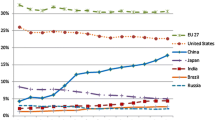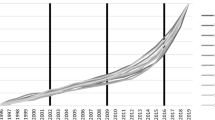Abstract
In this study, a series of relative indicators are used to compare the difference in research performance in biomedical fields between ten selected Western and Asian countries. Based on Thomson’s Essential Science Indicators (ESI) 1996–2006, the output of papers and their citations in ten biomedical fields are compared at multiple levels using relative indicators. Chart diagrams and hierarchical clustering are applied to represent the data. The results confirm that there are many differences in intra- and interdisciplinary scientific activities between the West and the East. In most biomedical fields Asian countries perform below world average.
Similar content being viewed by others
References
Adams, J. (1998), Benchmarking international research. Nature, 396: 615–618.
Bornmann, L., Mutz, R., Daniel, H. D. (2007), The b index as a measure of scientific excellence — a promising complement to the h index. Cybermetrics, 11(1), paper 6.
Braun, T., Glänzel, W. (1990), United Germany: the new scientific superpower? Scientometrics, 19: 513–521.
Cyranoski, D. (2001), Building a biopolis. Nature, 412: 370–371.
De Bruin, R., Kint, A., Luwel, M., Moed, H. F. (1993), A study of research evaluation and planning: the University of Ghent. Research Evaluation, 3: 25–41.
Egghe, L., Rousseau, R. (2002), A general framework for relative impact indicators. The Canadian Journal of Information and Library Science/La Revue canadienne des sciences de l’information et de bibliothéconomie, 27(1): 29–48.
Eisenhauer, J. G. (2003), Regression through the origin. Teaching Statistics, 25(3): 76–80.
Frame, J. D. (1977), Mainstream reseach in Latin America and the Caribbean. Interciencia, 2: 143–148.
Glänzel, W. (2001), National characteristics in international scientific co-authorship relations. Scientometrics, 51(1): 69–115.
Glänzel, W., Debackere, K., Meyer, M. (2008), ’Triad’ or ‘tetrad’ ? On global changes in a dynamic world. Scientometrics, 74: 71–88.
Gómez, I., Fernández, M. T., Zulueta, M. A., Cami, J. (1995), Analysis of biomedical research in Spain. Research Policy, 24: 459–471.
Guan, J. C., Ma, N. (2004), A comparative study of research performance in computer science. Scientometrics, 61: 339–359.
Horta, H., Veloso, F. M. (2007), Opening the box: comparing EU and US scientific output by scientific field. Technological Forecasting and Social Change, 74: 1334–1356.
Hu, XJ. (2007), Relative superiority coefficient of papers: a new dimension for institutional research performance in different fields. Scientometrics, 72: 388–403.
Jin, BH., Rousseau, R. (2005), China’s quantitative expansion phase: exponential growth but low impact. In: P. Ingwersen, B. Larsen (Eds) Proceedings of ISSI 2005. Stockholm: Karolinska University Press, pp. 362–370
Leydesdorff, L., Zhou, P. (2005), Are the contributions of China and Korea upsetting the world system of science? Scientometrics, 63: 617–630.
Lim, K. H. (2004), The relationship between research and innovation in the semiconductor and pharmaceutical industries (1981–1997). Research Policy, 33: 287–321.
Liu, L., Zhang, J. J. (2007), Characterising nanotechnology research in China. Science Technology & Society, 12: 201–216.
Must, Ü. (2006), “New” countries in Europe — Research, development and innovation strategies vs bibliometric data. Scientometrics, 66(2): 241–248.
Van Raan, A. F. J. (2004), Measuring science. In: H. F. Moed, W. Glänzel, U. Schmoch (Eds) Handbook of Quantitative Science and Technology Research. Dordrecht: Kluwer Academic Publishers, pp. 19–50
Rousseau, R. (2008), Triad or Tetrad: another representation. ISSI Newsletter, 4(1): 5–7.
Schubert, A., Braun, T. (1986), Relative indicators and relational charts for comparative assessment of publication output and citation impact. Scientometrics, 9: 281–291.
Schubert, A., Glänzel, W., Braun, T. (1983), Relative citation rate: a new indicator for measuring the impact of publications. In: D. Tomov, L. Dimitrova (Eds), Proceedings of the 1 st national Conference with International participation on Scientometrics and Linguistics of the Scientific Text, Varna (Bulgaria), pp. 80–81.
Schubert, A., Glänzel, W., Braun, T. (1989), World flash on basic research. Scientometric datafiles. A comprehensive set of indicators on 2649 journals and 96 countries in all major fields and subfields 1981–1985. Scientometrics, 16: 3–478.
Shelton, R. D., Foland, P., Gorelskyy, R. (2007), Do new SCI journals have a different national bias? In: D. Torres-Salinas, H. F. Moed (Eds) Proceedings of ISSI 2007, pp. 708–717.
Shelton, R. D., Holdridge, G. M. (2004), The US-EU race for leadership of science and technology: qualitative and quantitative indicators. Scientometrics, 60: 353–363.
Thorsteinsdóttir, H., Daar, A. S., Singer, P. A., Archambault, E., Arunachalam, S. (2006), Health biotechnology publishing takes-off in developing countries. International Journal of Biotechnology 8(1/2): 23–42.
Vinkler, P. (1998), General performance indexes calculated for research institutes of the Hungarian Academy of Sciences based on scientometric indicators. Scientometrics 41: 185–200.
Von Bubnoff, A. (2005), Asia squeezes Europe’s lead in science. Nature 436(7049): 314.
Wang T. Y., Chien, S. C., Kao, C. (2007), The role of technology development in national competitiveness — Evidence from Southeast Asian countries. Technological Forecasting and Social Change, 74: 1357–1373.
Wells, W. A. (2007), The returning tide. How China, the world’s most populous country, is building a competitive research base. Journal of Cell Biology, 178: 376–401.
Wu, R. (2004), Making an impact. Nature, 428: 206–207.
Yang, LY., Jin, BH. (2006), A co-occurrence study of international universities and institutes leading to a new instrument for detecting partners for research collaboration. ISSI Newsletter, 2(3): 7–9.
Zhou, P., Leydesdorff, L. (2006), The emergence of China as a leading nation in science. Research Policy, 35(1): 83–104.
Zitt, M., Bassecoulard, E. (2008), Challenges for scientometric indicators: data demining, knowledge-flow measurement and diversity issues. Ethics in Science and Environmental Politics, 8(5–7): 49–60. DOI: 10.3354/esep00092
Author information
Authors and Affiliations
Corresponding author
Rights and permissions
About this article
Cite this article
Hu, X., Rousseau, R. A comparative study of the difference in research performance in biomedical fields among selected Western and Asian countries. Scientometrics 81, 475–491 (2009). https://doi.org/10.1007/s11192-008-2202-9
Received:
Published:
Issue Date:
DOI: https://doi.org/10.1007/s11192-008-2202-9




